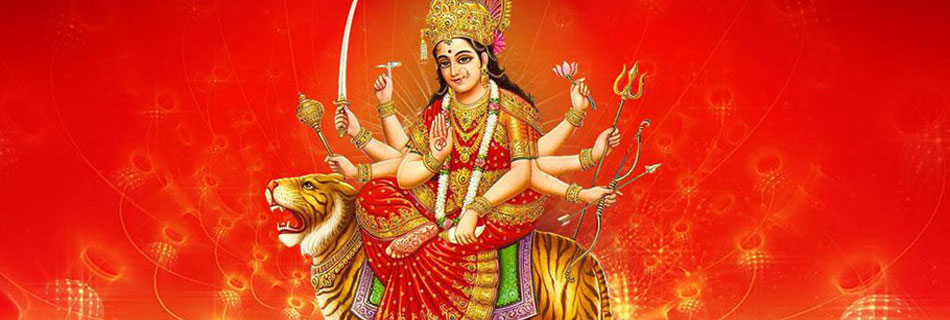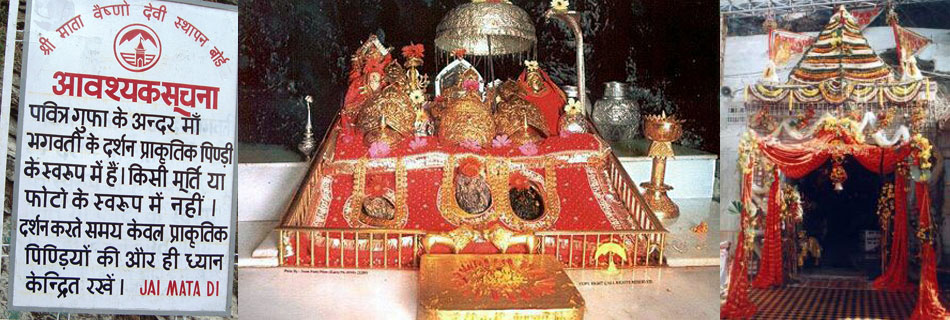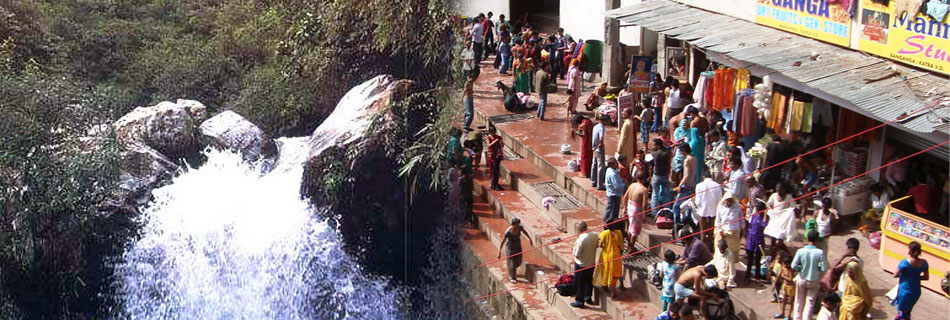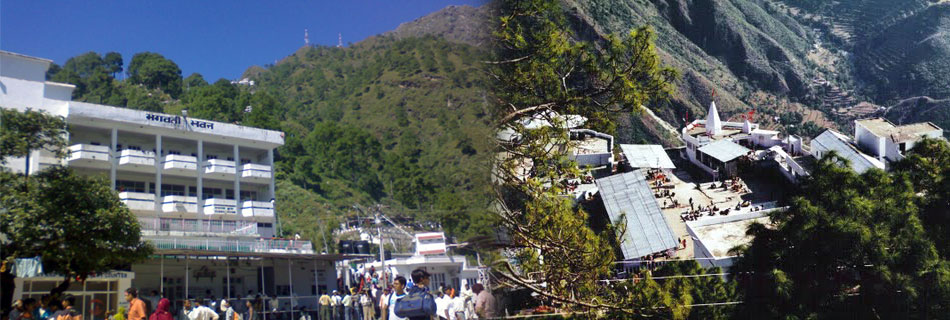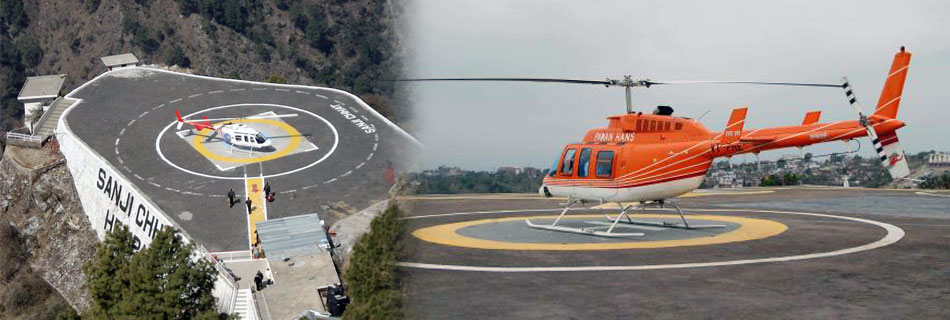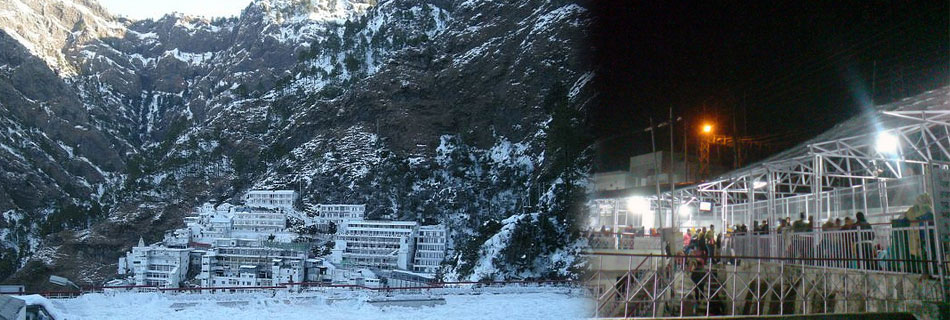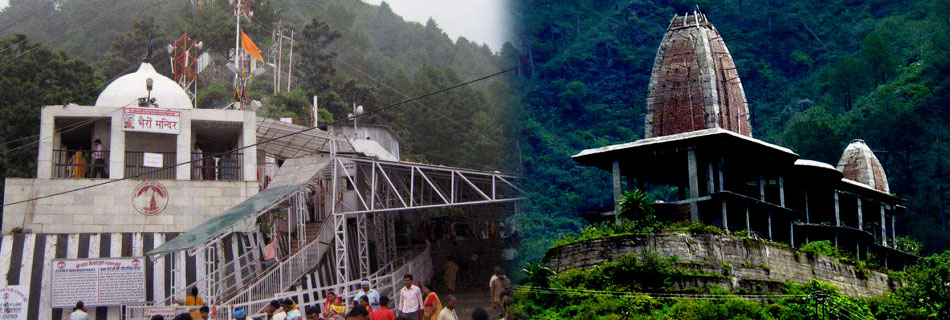
Bhawan
The Holy Bhawan houses the Sanctum Sanctorum – the Holy cave which is the ultimate destination of the yatries. Inside the Holy Cave the Goddess has revealed herself in the form of Holy Pindies manifesting Mata in her three forms Maha Kali, Maha Lakshmi and Mata Saraswati.A pilgrim can get the first glimpse of Bhawan around 1.5 Kms before he actually reaches there. The first sight of the Holy Bhawan brings a sudden upsurge of energy and all the tiredness of the strenuous climb evaporates immediately as if by a magic wave of some mystic wand. The fact that the last 1.5 km of the Yatra are either level or gently sloping downwards is a big relief to those tired muscles. The feeling of having almost reached there fills the devotees with extra fervor and devotion. The last 1.5 kms. are then covered on wings, as it were, and in no time, the yatri reaches Bhawan.
The Legend
It is believed that after leaving the Garbh Joon cave at Adhkawari, where Bhairon Nath had located her, Vaishnavi started ascending uphill till the time She reached the Holy Cave. Bhairon Nath who was pursuing Her, located her again inside the cave and started challenging her. So, finally the Goddess assumed Her Divine Form and severed the head of Bhairon Nath. There was so much power behind the blow of Her sword, that Bhairon Nath's head flew away and fell on another spur of the mountain about One & a half Kilometer away, (the site of modern day Bhairon Temple) while his torso was left lying at the Mouth of the Holy Cave. The Goddess then immersed Herself into deep meditation inside the Sanctum Sanctorum where lies Her manifestation in the petrified form.
Obtaining a Group Number
Yatries would recollect that prior to the commencement of their yatra, they had obtained a Yatra Registration Slip or Parchi from the Yatra Registration Counter (YRC) located at Katra. This slip had been checked and stamped at Banganga. The most important role of the slip is at Bhawan, where the slip is revalidated and used to issue a group number. The group number is allotted at the Yatra Slip Counter located on the left hand side immediately after the luggage check post. This group number would then determine the sequence in which the yatries would have the Holy Darshan and the time for which they would have to wait before obtaining Darshans.
Preparing for Darshans
Most pilgrims prefer to take a bath before proceeding for Darshans. In the olden days pilgrims used to take a bath at the Bathing Ghat, with the water that flows from the feet of Mata. With the passage of time, and particularly after the vesting of the management in the Shrine Board, new Bathing ghats and many toilets and bathrooms have been constructed. Attempts have been made to channelise the water from the Holy Cave to all these new Bathing areas, so that irrespective of where the pilgrim takes a bath, he receives the cleansing effect of the Holy Water. The traditional Bathing ghats have also been enlarged and developed and notwithstanding many constructions, many pilgrims would still like to take a bath at the original ghats.
Pilgrims are required to deposit all their belonging in the free cloakrooms, as nothing except cash and selected offerings (please read the section on Bhaints) are allowed inside the Holy Cave. All articles of general use like belts, wrist watches with leather belts, combs, pen, pencil, purses, handbags, etc. are prohibited. For the convenience of the yatries, Shrine Board has organized free cloak room facilities at many points in the Bhawan complex. In particular, a shoes/bags cloak room has been made operational just outside Gate No.1 which is the entrance to the queue complex. This cloak room can be used for depositing all leather and other goods which are prohibited inside the Holy Cave.
No sweets are allowed either. After taking a bath at the Bathing Ghat or elsewhere, pilgrims can reach Gate No.1 where upon announcement (and/or display on the display board) of the group number, they are allowed inside the queue which would lead them eventually to one of the greatest moments of their lives, a Darshan of the Divine Mother inside the Holy Cave in the natural rock form i.e. the Holy Pindies.
Coconut Prasad Counter
The traditional offering to the Goddess invariably comprises a coconut. However for reasons of time and security, coconut offerings are not allowed to be carried by the pilgrims beyond a designated point.
Instead, at a designated point in the main waiting hall, pilgrims have to deposit their coconuts to the temple priests who then take responsibility for the rituals. The pilgrim is handed over a token and the offered coconuts can be reclaimed after Darshans upon producing the token at the Coconut Prashad Counter.
Original Cave and New Tunnel
While on the way to the Sanctum Sanctorum, one crosses a small patio type of structure on the right hand side of which is a Cave opening. This is the original Cave leading to the Holy Pindies. In the olden days, the yatries used to reach the Sanctum Sanctorum through this cave only. Nowadays, this cave is kept closed for a large part of the year. Since this cave is quite narrow, it takes several minutes for a single person to cross it and reach the Sanctum Sanctorum.
Therefore, two new tunnels have been utilised to facilitate a larger number of pilgrims to have Darshans. One tunnel is used for the entrance and leads directly to the Sanctum Sanctorum. The other tunnel is used for exit. The original cave is opened during the lean periods or on traditional festivals or for ritualistic occasions. Obtaining Darshans through this Cave is a different experience altogether and pilgrims desirous of enjoying this Divine Bliss are well advised to plan their trip during the lean periods only.
Upon entering the tunnel, one should observe silence and carefully move in the queue. At the end of the tunnel is a raised marble platform on which the Divine Mother has revealed Herself in a natural rock form known as the Holy Pindies. Pilgrims should refrain from shouting slogans of praises inside the tunnel and around the Sanctum Sanctorum. This disturbs other pilgrims who may be interested in concentrating on the Darshans and on the description given by the priests.
The priest sitting on the platform, informs the pilgrims about these Pindies, however since the time for Darshans is limited, one only gets a glimpse of the Holy Pindies and has to move further in order to keep the queue moving. It is reiterated that Darshans inside the Holy Cave are in the form of natural rock formations called Pindies. There are no statues, pictures or idols inside. All along the track and at the Bhawan, there are many photographs explaining the nature of Darshans inside the Holy Cave. Yatries should observe these carefully since these are meant to guide them towards the final Darshans in the Holy Cave
Amrit Kund & Charan Ganga
Just outside the exit tunnel, towards the left hand side of the Cave is the Amrit Kund. This comprises the water taps through which flows the water of the Charan Ganga, the sacred water flowing from the feet of Mata. Pilgrims prefer to fill the Holy Water called Charanamrit in bottles and take it along with them for purification of their residences and cure of various ailments. Empty bottles and containers are available at the Bhaint Shops run by the Shrine Board.
Prasad
Outside the exit tunnel and just beyond the Amrit Kund lies the Prashad counter. The blessings of the Mother Goddess in the form of Prashad pouches are handed over to the devotees by the temple priests. Each Prashad pouch comprises the Mishri Prashad plus a blessed coin, carrying the image of the Holy Pindies. In addition, Khazaana (coins) are given to the devotees. This Khazaana Prashad is believed to be a good luck coin(s) and devotees would do well to keep it in their cash boxes, temples or other important places in their homes or establishments. It is not only a belief but a fact that the Khazaana Prashad wherever kept has brought in prosperity and luck.
Coconut Reclaim Counter
Yatries would recollect that Coconut Prashad had been handed over by them to the temple priests in the Waiting Hall and a token had been received in lieu of it. This token is now exchange for the blessed coconut at the Coconut Prashad counter. This counter is located on the right of the exit route.

Other Darshans Inside Cave
The Holy Cave is around 98 feet long. Besides the main Darshans of the Pindies inside the Cave, there are various other Darshans, outside and inside the Holy Cave and around the Holy Pindies. It is believed that the Darshans of 33 crore (330 million) Gods and Goddesses are present in the Holy Cave. It is believed that at some given point of time, each of the 330 million gods and goddesses have worshipped the Mother Goddess in the Holy Cave and have left their symbolical marks inside. It is also believed that during Poojan and Aarti in the morning and evening, all these Gods and Goddesses arrive at the Holy Cave to pay their obeisance to the Mother.At the entry of the Holy Cave, towards the left hand side, is the symbol of Vakra Tund Ganesh. Adjacent to the symbol of Lord Ganesh are the symbols of Surya and Chandra Dev. Once inside the Holy Cave, one crosses over the Dadh (torso) of Bhairon Nath, which is around 14 feet long. Due to the impact of the mighty blow of the Divine Mother, while the head of Bhairon Nath fell atop an adjacent mountain a couple of kilometers away from the Holy Cave, his body lay lifeless at the entrance of the Holy Cave.
After the Dadh (torso) of Bhairon is the symbol of Lord Hanuman known as Launkra Beer. Thereafter one comes across Charan Ganga, the legendary river flowing from the feet of Mata. Those having Darhans through the old Cave have to wade through water beyond this point. Around 23 feet beyond Launkra Beer, on the left upper hand side, the roof of the cave flares out and the entire weight of this cave appears to rest on the innumerable heads of Shesh Nag. Immediately below Shesh Nag is the Havan Kund of Mata and adjacent to it are the symbols of Shankh, Chakra, Gada and Padam.
Above, almost touching the ceiling of the cave are the symbols of five Pandavs, Sapt rishis, Than (udders or breast) of the divine cow Kamdhenu, symbols of Brahma-Vishnu-Mahesh and Shiv-Parvati. 3 feet further ahead, on an elevation can be seen the Khamba that was gripped by the legendary worshipper Prahlad. Diagonally below this, at the water level is the Yantra with innumerable mystical signs and symbols inscribed on it. 22 feet beyond this point is located the Sher Ka Panja, symbolizing the lion which is the mount of the Mata Vaishno Devi Ji. The distance from the entry point to the Sher Ka Panja is 59 feet. 13 feet beyond this, immediately above the head of the worshipper, is located the symbol of the Primary Hood of Shesh Nag which appears to be bearing the weight of the roof of the Cave at this point. 6 feet further ahead, on the left hand side, are the symbols of Shankar and Gauri.
13 feet beyond this are the Holy Pindies of Mata Maha Kali, Mata Maha Lakshmi Vaishno Devi and Mata Maha Saraswati. To the right of the Holy Pindies on the upper side can be seen the symbols of Lord Ganesh, Surya Dev, Chandra Dev and Goddess Annapurna. Slightly behind the Holy Pindies, on the right hand side can be seen the symbol of the seated Sinh Raj (Lion). A little ahead of it is the full hand of the Mother Goddess, raised in the Varad Hast mode, granting boons to the world. An interesting corollary to the Varad Hast of Mata lies in the story of the sacrifice of Sati. The Scriptures say that the hand of Mother Sati fell in the region of Kashmir creating a Shaktipeeth. There are a few sources, however, which believe that it was at this place i.e. the Holy Cave at Trikuta Mountain that the hand of Sati fell and the Varad Hast in the Holy Cave provides some link to the tale of Sati. Immediately opposite the Holy Pindies is the natural symbol of Lord Pashupati Nath.
Yatris may however note that most of these Darshans are possible only if the original cave is used. However, owing to the heavy rush, usually the new tunnels are used and the original cave is opened only during the lean seasons. Yatries desirous of having all the Darshans are advised to formulate their programme to correspond with the lean seasons.
After this can be seen the symbol of Lord Hanuman called Launkra. Water gushes out of the base of the holy Pindies and flows out of the holy Cave. This gush of Holy water is known as Charan Ganga and the water of this stream is collected in small containers by the devotees and taken home. The same water is also channelised to the bathing ghat and the devotees take a bath in this water before they join the queue for Darshan of the holy Pindies.



